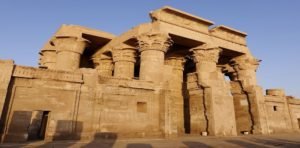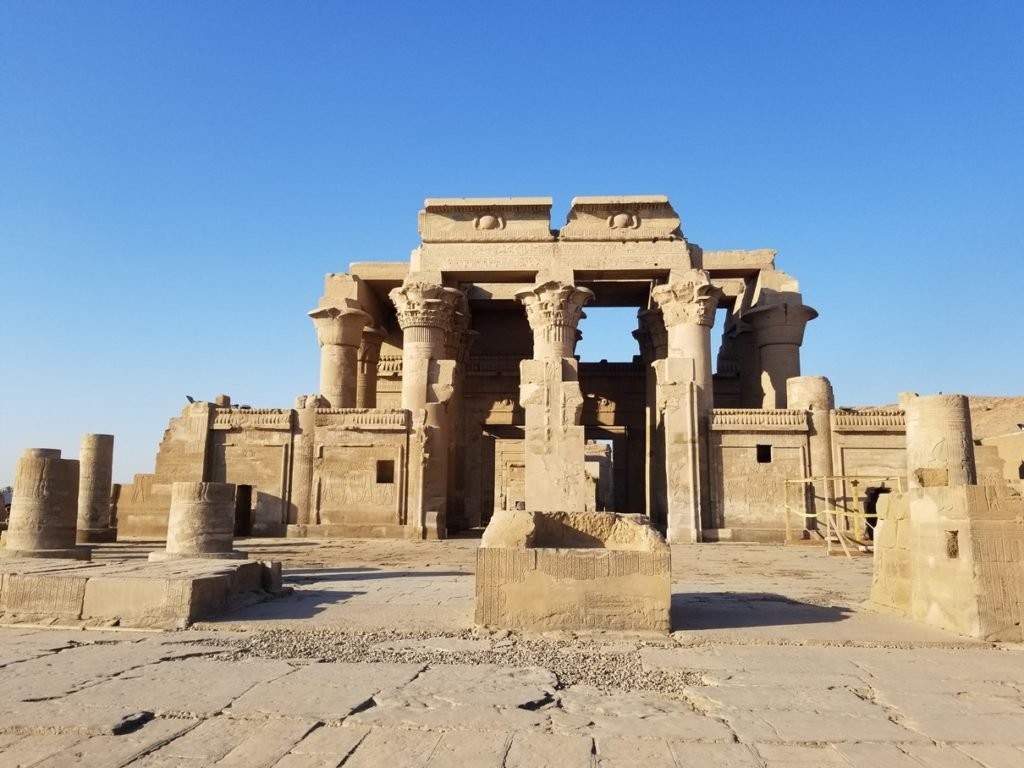Kom Ombo is located 45 km north of Aswan, 60 km south of Edfu, and 165 km south of Luxor on the eastern bank of the Nile. The city lies at a strategic point, leading to ancient gold mines in the eastern desert. It was also one of the great cities of the first nome of Upper Egypt.
Name of Kom Ombo:
The town was known as Nebit (from Nbw “gold”) in ancient Egypt and “Ombos” in the Greco-Roman period and “Ombo” in the Coptic language. The modern name Kom, means ‘pile’ and Ombo means ‘gold’ so it is the Pile of Gold because the temple was built on a higher place. Kom Ombo is now famous for this temple of Horus and Sobek.
History of the temple:
The Temple of Kom Omb is visited by the River Nile cruises or by the Dahabiya Nile cruises or by the Felucca boats and sometimes by road from Aswan or Luxor. It was built during the Greco-Roman period. It was built over the ruined temple of the New Kingdom. The temple began during the time of Ptolemy V and was completed by the time of Emperor Tiberius. The emperors Domitian, Caracalla, and others added to the temple. So it took about 400 years to finish.
The temple is dedicated to the two triads of Horus and Sobek. The right part of the temple is dedicated to Sobek (Crocodile deity), his consort Hathor and their son Khonsu. The left part of the temple is dedicated to Horus the Elder (Heru-ur or Haroeris), his consort Tasenetnofret (“the good sister”), and their son Panebtawy (the Lord of the Two Lands).
Nothing to separate between the two parts of the temple, just an imaginary line made by the goddess Ma’at (deity of Justice in ancient Egypt).
Description of the temple:
The temple was built from the north to the south and entered from the first pylon. This pylon dates back to emperor Domitian, and a large part of the pylon is missing. The pylon leads to the open court. This court was built by Emperor Tiberius and has 16 columns.

The court takes you to the Great Hypostyle Hall. The hall consists of 15 columns. This hall was built during the reign of Ptolemy XII. A beautiful scene of the coronation of the king is when the king receives the Ankh symbol from goddess Sekhmet.
Second Hypostyle Hall:
The Great Hypostyle Hall leads to a smaller Hypostyle Hall. The smaller hall consisted of 10 columns, dating back to Ptolemy VIII. A very detailed scene of the coronation of the pharaoh is found in this hall. The king is being purified by Gods Horus and Thoth, then receiving the crowns of Upper and Lower Egypt from Nekhbet (Upper Egypt) and Wadjet (Lower Egypt). After that, the king has rewarded the Khepresh (victory) sword. This hall leads to two other rooms and finally to the sanctuary of the temple. There are 7 rooms in the back of the sanctuary, working as storerooms or for another reason.

The temple was famous for being a sanatorium, so the famous scene of the surgical instruments is depicted on the enclosure wall behind the storerooms. The king of Egypt offers some surgical instruments to Imhotep, the vizier of Djoser, and the architect of the Step Pyramid in Saqqara. Imhotep was deified as the deity of medicine and engineering during the Greco-Roman period. Some of these tools are still in use by surgeons till now.

A magnificent Nilometer is found on the left side of the temple. The Nilometer is well-like in shape to measure the level of the flood, taking into account farmers’ taxes every year. After the construction of the Aswan Dam in 1902, the function of the Nilometer ceased.
A new small museum was built in the vicinity of the temple in 2012. The Crocodile Museum houses 31 crocodile mummies. Good museum, take a look.
Kom Ombo Temple is included in most of our Egypt tour packages as well as some of Aswan Day Tours and Luxor Day Tours.

